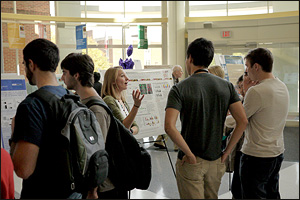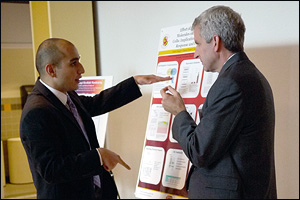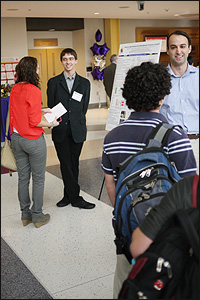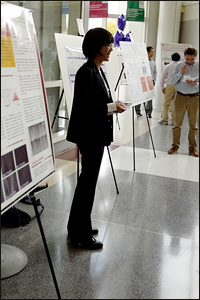


The Fischell Department of Bioengineering at the University of Maryland presents:THE 2012 FISCHELL FESTIVAL:A Celebration of Bioengineering's Potential to Improve Life for Millions of People
On October 18, 2012, the Fischell Department of Bioengineering (BioE) held its sixth Fischell Festival, which highlighted the latest in biomedical research in talks and posters presented by a diverse group of scientists from academia, federal laboratories, hospitals, and industry. Return to the Fischell Festival homepage » Contents:
Welcome and Fischell Fellow Announcement
After welcoming Fischell Festival guests and presenting a brief update on the department's research program, partnerships, rise in school rankings, and soaring undergraduate enrollment, BioE Professor and Chair William E. Bentley turned the floor over to department benefactor and namesake Dr. Robert E. Fischell. Looking back to 2006, Fischell told the audience how he accepted a lunch invitation from then-Clark School dean Nariman Farvardin and University System of Maryland chancellor Brit Kirwin, who asked him to sponsor a new department of bioengineering at College Park. "The lunch was so good, I said yes," Fischell joked. "But," he added, "never at that time did I think, frankly, that it could be anything like what it is today…I thought maybe we'd get ten [students], then maybe 20, and maybe someday we'd get to a total class of maybe 80, maybe 100 people on a good day." Despite these expectations, total undergraduate enrollment has increased from fewer than 50 students in 2006 to close to 400 as of Fall 2012. "That gives me tremendous satisfaction," said Fischell, "and it [has] a lot to do with Bill Bentley's great leadership."
Bentley's welcome concluded with the introduction of the department's newest Fischell Fellow, first-year graduate student Mina Choi. Choi comes to the University of Maryland from The George Washington University, where she earned her B.S. in biomedical engineering and her M.S. in electrical engineering. Before applying to the Ph.D. program, she spent two years at the FDA studying how eyes process images presented on high dynamic range displays. At the Clark School, Choi hopes to continue pursue her interests in medical imaging and simulations. "I'm just so grateful for [the Fellowship]," she said. "I'm going to work really hard to deserve it." Video »
Keynote Address: Elliot R. McVeigh: "Training for the Real World by Working in the Real World"–A Brief History of Interventional MRI
This year, our keynote address was delivered by Elliot R. McVeigh, director of the Department of Biomedical Engineering at the Johns Hopkins University School of Medicine. McVeigh, the inventor of technologies such as realtime magnetic resonance imaging (MRI), stressed the importance of partnerships among doctors and engineers. He opened his presentation with advice for all students and aspiring medical device designers. "The best idea," he told the audience, "is to embed yourself as closely as possible to the people who are going to use [your] technologies as opposed to inventing in a vacuum and then looking for a use." In relating his own experiences in the field of cardiovascular and interventional MRI, he explained how the solution to one problem led to decades of advances in cardiovascular imaging, thanks to his successful collaborations with radiologists and cardiologists. Starting with a means to measure heart wall motion using MRI by creating a heart marking system, McVeigh and his team were first able to create still images, then assemble image slices into 3D models. The system was subsequently modified to detect the thickening of heart muscle associated with disease. Series of images were later translated into animations that allowed doctors to discern the timing of the heart's contractions, which in turn made it easier to determine whether a patient would respond to resynchronization therapy. When the system moved from animations to live imaging, interventionists were finally able to use MRI to guide their procedures and see soft tissue in realtime. Each leap forward was made possible by both the one before it and the application of what McVeigh had learned by fulfilling the increasingly challenging requests doctors made of his team. "Just because a technology is known to solve one problem, don't assume it won't solve others," said McVeigh. "In fact, if your tech fails in one context, don't give up, and keep an open mind, because it might work great in another." He also stressed the need to engage in collaborative design, citing a situation in which he and his colleagues designed a robotic arm capable of operating inside an MRI machine, when what doctors really wanted was a larger MRI chamber, into which they could look, reach, and interact with the patient directly. In conclusion, McVeigh advised engineers to acquire a versatile set of skills, keep their desire to learn, embed themselves in clinical environments, and maintain their commitment and passion, because all of these necessary to see an innovation enter clinical practice. Learn all about Dr. McVeigh's innovations in interventional MRI by watching the full lecture » Silvia Muro: "Designing Nanomedicines to Overcome Physiological Barriers"
The pharmaceutical industry, Associate Professor Silvia Muro told the audience, now generates approximately $1 trillion in revenue annually worldwide, with the U.S. controlling 35-40% of the market. Innovation is poised to translate into lives saved and big rewards for those who can provide effective treatments, but there are still substantial roadblocks keeping new drugs from consumers. One of these roadblocks isn't an inability to discover drugs capable of treating diseases, said Muro, but the obstacles within our own bodies. An inability to transport drugs into and across the gastrointestinal (GI) tract or blood/brain barrier keeps them from reaching their destinations. Drugs that are metabolized too quickly or too slowly, degrade before they reach their destination, are toxic to healthy areas of the body, or provoke an immune system response will have reduced or even no efficacy. "Delivery is the bottleneck," Muro explained. But, she added, these challenges have resulted in a "surge" of research, including her own, that has produced delivery systems—molecules which do not have a direct effect on disease, but which aid drug delivery though the routing, protecting, and "presenting" therapeutics in more effective ways. Muro described how her group used drug nanocarriers that target a protein found in the epithelial cells of the GI tract, ICAM-1. The nanocarriers are designed to prompt the cells to ingest and move the drugs using their natural vesicular endocytosis mechanisms rather forcing therapeutics through the junctions between them. These "natural transport pathways" result in more therapeutic molecules reaching their destination, and are also safer, since forcing openings between cells can also allow unwanted molecules to pass through along with the drug.
Anne L. Plant: Transforming Beautiful Cell Imagery Into Predictive Models
After spending 20 years as a biophysical chemist, Anne Plant, Chief of the National Institute of Standards and Technology's (NIST) Biosystems and Biomaterials Division, decided to return to a field that she had found inspiring and beautiful while in graduate school: biological imaging. "The point that really struck me after being away from imaging for 20 years," she said, "was to realize that people are still taking very pretty pictures of cells, and they could be a very good source of information, but they're often not used in a very quantitative way, particularly in cell biology." With dynamic cellular processes and the prospect of harvesting rich amounts data from them in sight, Plant's research group developed a new goal: To extract quantitative information from cell images that could be used develop predictive models of very complex biological behaviors. Cells are smallest complete, complex entity that can be studied in biology, and contain most or all of the phenomenology that is important to understand. Much of NIST's mission is to help industry make effective products. Viable, marketable biomedical or pharmaceutical products require a known cellular response, reproducibility of effect, assurances of safety, and a predictable level of potency. Because cell biology is not yet a quantitative, predictive science, the commercialization of new cell therapies—particularly those involving stem cells—is challenging. Since biological systems are highly complex and affected by many conditions, quantitative data is essential to predicting in vivo responses to therapeutics. Models that average cell response aren't accurate enough, Plant said, because stochastic fluctuations among populations of cells need to be taken into account. "We want to…say, 'How is this cell different from that cell, and why? And what happens to those cells differently some time in the future because they were different early on?'" The only way to answer those questions, she said, is to examine individual live cells, one at a time, which she and a team of fellow scientists and students painstakingly did as they furthered the development of live cell microscopy. Statistical and computational experts were ultimately able to develop the algorithms necessary to take the collected live cell data and quantify what each cell in a group is doing over time. The team also validated the tools that produced their results to ensure overall accuracy.
Thomas J. Fogarty: The Plight of the Innovator
The Fischell Festival concluded with a Whiting-Turner Business and Entrepreneurial lecture delivered by internationally recognized cardiovascular surgeon, entrepreneur, and inventor Thomas J. Fogarty. Over the past 40 years, Fogarty has acquired 135 surgical patents, including the industry-standard Fogarty Balloon Catheter and the widely used Aneurx stent graft. He is the recipient of the Jacobson Innovation Award from the American College of Surgeons, and an elected member of the Invention Hall of Fame and the National Academy of Engineering. Fogarty's presentation, titled "The Plight of the Innovator–How to Get Out of It," opened with what seemed like a dire proclamation: "I want to make it very clear," said Fogarty, "[that] you're not going to get out of it. You're just going to handle it." Fogarty's own career did not have the most auspicious start. In 1960, while working for his mentor, Dr. Jack Cranley, a vascular surgeon, he was asked to help find a better way remove blood clots and embolisms. At the time, available surgical interventions had a 50% mortality rate. Their partnership led to the development of the balloon catheter, which is now the standard of care. But academia initially rejected the invention despite its success rate, calling it a dangerous and inappropriate concept that could only be dreamed up by an inexperienced student. "The greatest challenge [to innovation] is displacing the old," said Fogarty. "You're not going to be looked upon kindly." But, he added, "By replacing yourself, you often do something that is a lot better for the patient." But his experience with Cranley, which occurred prior to the existence of the U.S. Food and Drug Administration (FDA), seems easy compared to what biomedical device designers go through now. Development and release of the balloon catheter cost Fogarty and Cranley $1800 and took about two months from concept to first use. A device Fogarty created in 1998 has cost over $2 billion in development and testing, and is still awaiting approval. "Innovation in…the United States, particularly for medical devices, drugs, and pharmaceuticals, is under attack," said Fogarty. "We still come up with the most brilliant concepts, but unfortunately we're not able to implement these concepts like we used to be able to do." So what happened? Fogarty pointed to a variety of culprits: changes in inventors' and doctors' relationships with industry and academia, conflicts of interest, "committeeism," overregulation, diminishing rewards for inventors relative to the cost of getting a product to market, and the complexity of the evaluation of new technology. He also cited the difference in pace between academia and industry: by the time a new doctor spends eight years earning a degree, technology outside of school has changed. Companies can assist by teaching students about their products, but are often barred from campuses. He isn't against testing and safety, he told the audience, but he does feel that U.S. regulations and culture have made successful product development unsustainable. The result is that the U.S. is losing ground: the number of clinical studies, manufacturing, interest in investment, and inventor reimbursement are all down, while regulation, insurance costs, oversight, development costs and taxes have skyrocketed. Research, clinical trials, and drug and device manufacturing are moving offshore—and the patients have started to follow, traveling to countries offering more affordable care and treatment options unavailable in the U.S. Fogarty urged everyone to make themselves aware of these issues, to speak up, and not to give up on their pursuits. "We have not designed instrumentation or drugs with cost in mind," he said, noting that now more than ever, we need to do more with less. "We can't afford to innovate in the United States under current circumstances." Video » Thank You! This year's poster session attracted participants from Johns Hopkins 
BioE Professor and Chair William E. Bentley (right) discusses   Above: Graduate students and guests discussing research at the poster session. The Fischell Department of Bioengineering would like to thank the Fischell family, all of the Fischell Festival's speakers, guests, and volunteers, and University of Maryland students, faculty and staff, for a wonderful and informative event. We hope to see you all next year! Return to the Fischell Festival homepage » Were you unable to attend one of our previous Fischell Festivals?See photos, read reviews and watch presentations from past Fischell Festivals:
|
Through a $31 million gift, Robert E. Fischell and his sons Tim, Scott and David established the Fischell Department of Bioengineering and the Robert E. Fischell Institute for Biomedical Devices at the Clark School of Engineering. "The greatest achievement that engineering can make is to improve the quality of life for millions of people. Our gift will help young engineers develop their ideas to improve healthcare for human beings throughout the world."Robert E. Fischell, M.S. '53, Physics
"The best idea is to embed yourself as closely as possible to the people who are going to use [your] technologies as opposed to inventing in a vacuum and then looking for a use."Elliot R. McVeigh, Massey Professor and Director, Department of Biomedical Engineering, Johns Hopkins University School of Medicine
"This lack of ability to properly treat these diseases is not really [about] an inability in [the] discovering and designing of therapeutic molecules...but rather because of the other types of obstacles that disable our ability to implement those therapeutic molecules...Delivery is the bottleneck."Associate Professor Silvia Muro, Fischell Department of Bioengineering and Institute for Bioscience and Biotechnology Research, University of Maryland
"The point that really struck me...was to realize that people are still taking very pretty pictures of cells, and they could be a very good source of information, but they're often not used in a very quantitative way,"Anne L. Plant, Chief, Biosystems and Biomaterials Division, National Institute of Standards and Technology
"Innovation...in the United States, particularly for medical devices, drugs, and pharmaceuticals, is under attack…the state of innovation relative to medicine in the United States is not where it should be. It is going backwards. Does that mean we're stupid? No. We still come up with the most brilliant concepts, but unfortunately we're not able to implement these concepts like we used to be able to do."Internationally-recognized cardiovascular surgeon, entrepreneur, and inventor Thomas J. Fogarty, creator of the balloon catheter. |